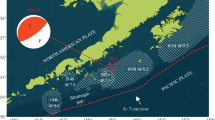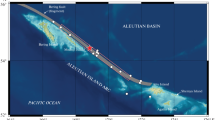Abstract—For the first time, based on the synthetic-aperture radar interferometry data (InSAR), a surface rupture model of the earthquake that occurred on January 12, 2021 beneath Lake Khuvsgul (Khubsugul, Khövsgöl), Mongolia, is built. In the constructed model, the rupture of this region-largest instrumental event strikes northwest, has a dip angle of 45°, a slip rake angle in the interval from –130° to –150°, and a mean displacement of 1 m. The rupture extends to a depth of 18 km and has a strike length of 26 km. In contrast to the surface rupture model built by the US Geological Survey from seismological data, the model based on the InSAR data shows that in the northern part of the lake, the main Khuvsgul fault strikes northwest. The obtained result requires increasing the existing estimates of the length of the seismogenic part of the Khuvsgul fault severalfold.



Similar content being viewed by others
REFERENCES
Arzhannikova, A.V., Parfeevets, A.V., San’kov, V.A., and Miroshnichenko, A.I., Late Cenozoic kinematics of active faults in the Hovsgol basin (southwestern flank of the Baikal rift), Russ. Geol. Geophys., 2003, vol. 44, no. 11, pp. 1162–1167.
Bachmanov, D.M., Kozhurin A.I., and Trifonov V.G., The active faults of Eurasia database, Geodinam. Tektonofiz., 2017, vol. 8, no. 4, pp. 711–736.
Delvaux, D., Moeys, R., Stapel, G., Petit, C., Levi, K., Miroshnichenko, A., Ruzhich, V., and San’kov, V., Paleostress reconstructions and geodynamics of the Baikal region, Central Asia, Part 2. Cenozoic rifting, Tectonophysics, 1997, vol. 282, nos. 1–4, pp. 1–38.
Dobrynina, A.A., San’kov, V.A., Chechel’nitsky, V.V., Tsydypova, L.R., and German, V.I., Seismoacoustic effects of the Hovsgol earthquake (M w = 4.9) of December 5, 2014, Dokl. Earth Sci., 2017, vol. 477, no. 2, pp. 1494–1497.
Klyuchevsky, A.V., Dem’yanovich, V.M., Demberel, S., and Bayar, G., Comprehensive analysis of seismicity and strong earthquakes in the territory of Mongolia, in Opasnye geologicheskie protsessy i prognozirovanie chrezvychainykh situatsii prirodnogo kharaktera na territorii Tsentral’noi Mongolii (Hazardous Geological Processes and Forecasting of Natural Disasters in the Territory of Central Mongolia), Gladkochub, D.P., Ed., Irkutsk: Izd-vo IGU, 2017, pp. 68–92.
Kocharyan, G.G., Geomekhanika razlomov (Fault Geomechanics), Moscow: GEOS, 2016.
Kochetkov, V.M., Khil’ko, S.D., Zorin, Yu.A., et al., Seismotektonika i seismichnost’ Prikhubsugul’ya (Seismotectonics and Seismicity of the Khubsugul Region), Novosbirsk: Nauka, 1993.
Lunina, O.V. and Gladkov, A.S., Fault pattern and stress field in the western Tunka rift (southwestern flank of the Baikal rift system), Russ. Geol. Geophys., 2004, vol. 45, no. 10, pp. 1188–1199.
Mel’nikova, V.I., Gilova, N.A., Seredkina, A.I., and Radziminovich, Ya.B., Strong earthquakes in the southwestern flank of the Baikal rift in 2014: Urikskoe on November 1 with K P = 13.6, M W = 4.6, I 0 = 7–8 and Khubsugul on December 5 with K P = 13.9, M W = 4.9, I 0 = 7–8, in Zemletryaseniya Severnoi Evrazii, tom 23 (Earthquakes of Northern Eurasia, vol. 23), Moscow: RAN, 2014, pp. 350–363.
Mikhailov, V.O., Nazaryan, A.N., Smirnov, V.B., Diament, M., Shapiro, N., Kiseleva, E.A., Tikhotskii, S.A., Polyakov, S.A., Smol’yaninova, E.I., and Timoshkina, E.P., Joint inversion of the differential satellite interferometry and GPS data: A case study of Altai (Chuia) Earthquake of September 27, 2003, Izv., Phys. Solid Earth, 2010, vol. 46, no. 2, pp. 91–103.
Mikhailov, V.O., Kiseleva, E.A., Smol’yaninova, E.I., Dmitriev, P.N., Golubev, V.I., Isaev, Yu.S., Dorokhin, K.A., Timoshkina, E.P., and Khairetdinov, S.A., Some problems of landslide monitoring using satellite radar imagery with different wavelengths: Case study of two landslides in the region of Greater Sochi, Izv., Phys. Solid Earth, 2014, vol. 50, no. 4, pp. 576–587.
Mikhailov, V.O., Timoshkina, E.P., Smirnov, V.B., Khairetdinov, S.A., and Dmitriev, P.N., On the origin of postseismic deformation processes in the region of the Maule, Chile earthquake of February 27, 2010, Izv., Phys. Solid Earth, 2020, vol. 56, no. 6, pp. 762–771.
Pollitz, F.F., Coseismic deformation from earthquake faulting on a layered spherical Earth, Geophys. J. Int., 1996, vol. 125, no. 1, pp. 1–14.
Radziminovich, N.A., Bayar, G., Miroshnichenko, A.I., Demberel, S., Ulziibat, M., Ganzorig, D., and Lukhnev, A.V., Focal mechanisms of earthquakes and stress field of the crust in Mongolia and its surroundings, Geodyn. Tectonophys., 2016, vol. 7, no. 1, pp. 23–38. https://doi.org/10.5800/GT-2016-7-1-0195
Sadovskii, M.A., Pisarenko, V.F., and Steinberg, V.V., On the dependence of earthquake energy on the volume of seismic source, Dokl. Akad. Nauk SSSR, 1983, vol. 271, no. 3, pp. 598–602.
Sankov, V.A. and Parfeevets, A.V., The Cenozoic crustal stress state of Mongolia according to geological and structural data (a review), Geodinam. Tektonofiz., 2020, vol. 11, no. 4, pp. 722–742.
Solonenko, A.V., Solonenko, N.V., Mel’nikova, V.I., Koz’min, B.M., Kuchai, O.A., and Sukhanova, S.S., Stresses and displacements in the sources of earthquakes in Siberia and Mongolia, in Seismichnost’ i seismicheskoe raionirovanie Severnoi Evrazii, tom 1 (Seismicity and Seismic Zoning of Northern Eurasia, vol. 1), Moscow: OIFZ RAN, 1993, pp. 113–122.
ACKNOWLEDGMENTS
We thank F. Pollitz for providing the Static1D software and European Space Agency for providing the Sentinel-1 satellite images and SNAP software. We are grateful to the reviewers of our paper P.N. Shebalin, Yu.O. Kuzmin, and G.G. Kocharyan for their valuable comments.
Funding
The work was supported by the Interdisciplinary Scientific and Educational School “Fundamental and Applied Space Research” of Moscow State University. The development of methods for inverse problem solution is carried out within the framework of the State Assignment of the IPE RAS.
Author information
Authors and Affiliations
Corresponding author
Ethics declarations
The authors declare that they have no conflicts of interest.
Additional information
Translated by M. Nazarenko
A year ago, on January 12, 2021, a strong earthquake occurred near Lake Baikal in the region of Lake Khuvsgul, Mongolia. In this issue of Izvestiya, Physics of the Solid Earth, we publish two papers devoted to this earthquake.
Rights and permissions
About this article
Cite this article
Timoshkina, E.P., Mikhailov, V.O., Smirnov, V.B. et al. Model of the Rupture Surface of the Khuvsgul Earthquake of January 12, 2021 From InSAR Data. Izv., Phys. Solid Earth 58, 74–79 (2022). https://doi.org/10.1134/S1069351322010098
Received:
Revised:
Accepted:
Published:
Issue Date:
DOI: https://doi.org/10.1134/S1069351322010098




